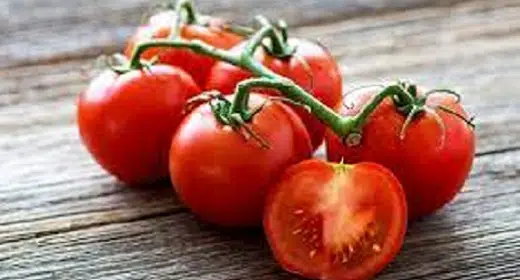by Ocean Robbins: The second-century physician Galen wrote about a dangerous plant that he called lycopersion, which roughly translates from the Greek as “wolf peach…”
We are proud to announce a new partnership with John and Ocean Robbins and the Food Revolution to bring our readers Summits, Seminars and Masterclasses on health, nutrition and Earth-Conscious living.
Sign Up Today For the Healthy Brain Masterclass
This name reflected a contemporary belief that eating the fruit of this plant could turn people into werewolves.
A millennium and a half later, Carl Linnaeus, the fellow who created the taxonomic naming system we use today, was casting about for a reasonable Latin name for the tomato, which had recently been introduced into Europe from the Americas. At the time, most people thought tomatoes were poisonous, and Linnaeus reinforced that idea by borrowing from Galen. The tomato, Linnaeus decided, was now Solanum lycopersicum, or “wolf-peach of the nightshade family,” a dangerous group that included poisonous and hallucinogenic species long associated with witchcraft and the occult.
In 1768, just 15 years after Linnaeus maligned the tomato, British gardener Philip Miller attempted to rehabilitate it with a new name, Lycopersicon esculentum, meaning “edible wolf-peach.” (You can read all about how the tomato went from reviled to beloved in our full article here.)
You’ll notice that the wolfy prefix “lyco” still describes the tomato. And that’s where we get the word lycopene, one of the compounds in the tomato that, rather than turning you hairy and feral during the full moon, can protect your body from more common chronic conditions.
Lycopene is best known for its association with tomatoes, but it appears in a few other plants as well, most of them reddish in hue. In this article, we’ll look at how lycopene can benefit your health, and where, in addition to red tomatoes, you can get it.
What Is Lycopene?
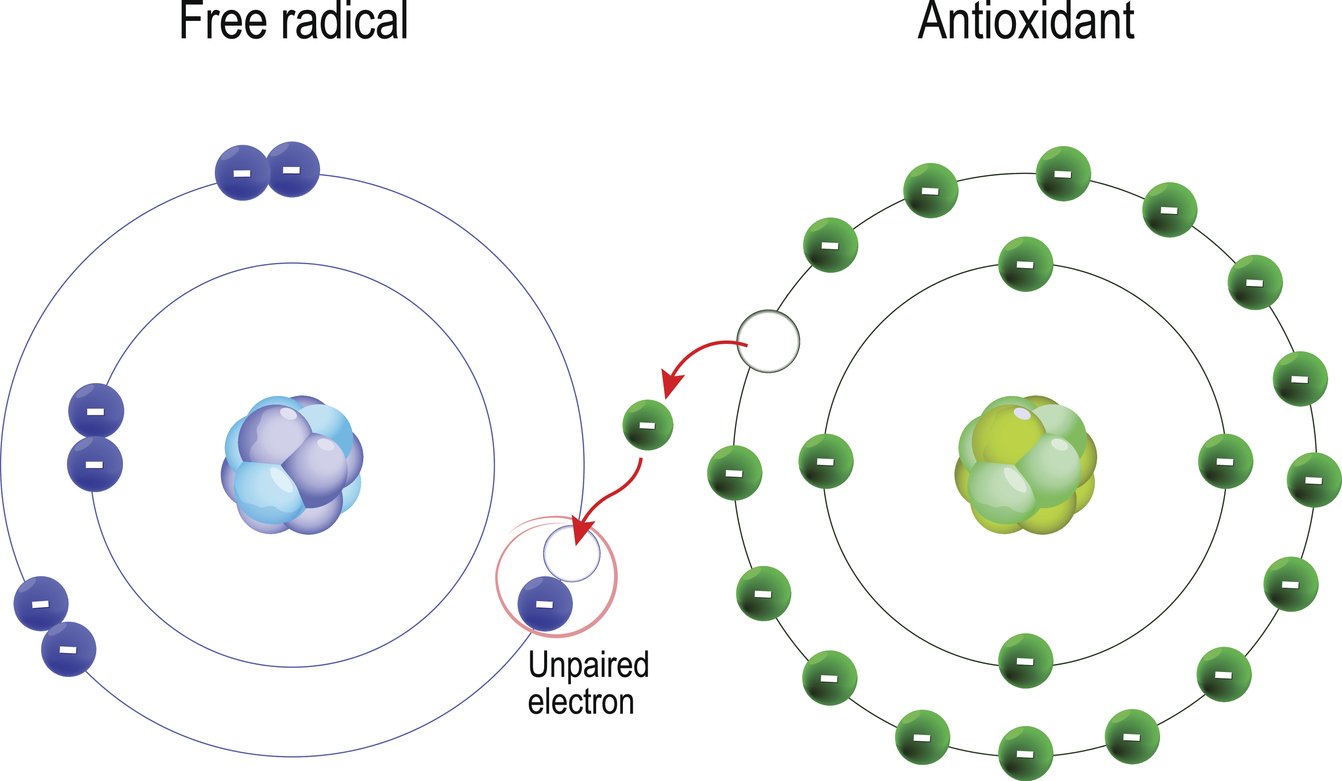
Lycopene is an antioxidant, which means it fights free radicals in your body that, left unchecked, can cause oxidative stress and disease. It’s a member of the carotenoid family, which are naturally occurring compounds that contribute to the red and orange colors of some fruits and vegetables.
Lycopene is also known as a non-provitamin A carotenoid (that is, unlike most carotenoids, your body doesn’t convert it to vitamin A). Instead, lycopene benefits your health by protecting fats, proteins, and DNA from oxidative damage. In fact, it more than makes up for not turning into vitamin A by having the highest antioxidant potential of all the carotenoids. (For some reason, this makes me think of Rudolph the Red-Nosed Reindeer. Is it a coincidence that both his nose and lycopene are red? I think not.)
Lycopene is primarily stored in the liver, testes, adrenal glands, and adipose (fat) tissues, with lower concentrations in the kidneys, ovaries, lungs, and prostate. As your body can’t manufacture it, you must source it from food. But you can’t get it by eating like a werewolf — lycopene only occurs naturally in plants, not animals.
Lycopene Health Benefits

The more we learn about lycopene, the more we find out about its myriad health benefits. Here are a few of its best-documented positive effects.
Lycopene and Cancer
Lycopene does several things to fight the progression and spread of cancer — especially cancers of the prostate, breast, lungs, and stomach. It inhibits cell growth, keeps cancer cells from proliferating, encourages cancer cell death (“apoptosis”), and keeps tumors from invading other parts of the body. There’s also evidence that lycopene can enhance the effectiveness of some anticancer pharmacotherapy.
Lycopene and Fertility in Men
One effect of high levels of oxidation in the body is damage to sperm. Lycopene targets reactive oxygen species (ROS) to minimize or prevent this effect, helping to reduce DNA damage, sperm death, and degradation of sperm cell membranes. In these ways, lycopene can maintain healthy sperm motility, concentrations, and form.
A 2020 clinical trial showed that 12 weeks of lycopene supplementation improved sperm motility and morphology in healthy young men, compared to the placebo. So for men who are found to be sub-fertile (because of sluggish sperm, or just not enough of them), adding lycopene to the diet may help — along with quitting smoking, losing any excess weight, and swapping out tight briefs for more breathable underwear, all of which have been found to be helpful for fertility, as well.
A 2021 rat study demonstrated some of the molecular pathways by which lycopene benefits sperm. The two main ones included reducing ROS and increasing antioxidant activity. (Our view on the use of animals in medical research is here.)
Lycopene and Heart Health
Lycopene helps protect against oxidative damage to the cardiovascular system. It can regulate blood pressure using the same pathways as the ACE inhibitor class of antihypertensive drugs, as well as improving the bioavailability of nitric oxide, a compound that dilates blood vessels. Lycopene also helps lower LDL (“bad”) cholesterol and raise HDL (“good”) cholesterol to prevent plaques and atherosclerosis.
A 2006 study measured serum levels of lycopene in 3,000 Japanese men and followed them for 12 years. Those with the highest levels had the lowest risk of dying from cardiovascular disease.
Is Lycopene Anti-Inflammatory?
Inflammation is one root cause of many different chronic disorders and diseases, including type 2 diabetes, Alzheimer’s, asthma, allergies, mood disorders, and arthritis. And it turns out that lycopene is a powerful anti-inflammatory compound. It particularly fights inflammation in the liver, arterial cell walls, and adipose (fatty) tissue. This last is especially significant because much of the damage caused by obesity is fueled by inflammatory compounds that are released by excess adipose cells. So lycopene may be especially helpful for anyone carrying significant excess weight.
A 2012 study found that drinking tomato juice daily reduced inflammatory markers in obese and overweight women, compared to those who were just given water to drink. The researchers surmised that lycopene benefits might include helping to break the link between obesity and inflammatory conditions such as diabetes and cardiovascular disease.
Lycopene Brain Benefits
A study of rats, conducted in 2020, may have significant implications for human health. The compound Bisphenol A (BPA) is an endocrine disruptor found throughout our environment, from plastics to food cans, sporting goods, appliances, cash register receipts, eyeglass lenses, and medical equipment. BPA leaches from these items into the human body, where it’s been found in blood, sweat, and urine for many years now. Among its many harmful effects, BPA is a neurotoxin that can impair cognitive function.
Researchers exposed rats to BPA. Some of the rats were also given lycopene to see if the carotenoid would protect them from some of the cognitive harm. The lycopene-fed rats performed significantly better on memory and cognition tests. Their hippocampi (the part of the brain associated with the consolidation of memory) were protected from BPA intoxication, and neuronal cells lived longer in the presence of lycopene.
It turns out that lycopene might protect not just the brain, but the entire nervous system. Other conditions that can be helped by sufficient dietary or supplemental lycopene may include neurodegenerative disorders, epileptic conditions, aging, spinal cord injury, neuropathy, and subarachnoid hemorrhage (which is bleeding in a specific region of the brain, and not the blood dripping from a spider’s web after a particularly brutal meal).
Lycopene for Skin Health
When we compliment someone on how young they look, we’re usually referring to their skin (since unless we have x-ray vision, we’re likely not able to see the functional age of, say, a kidney or spleen). What promotes healthy skin may also contribute to the slowing of the aging process. And one of lycopene’s best antioxidant tricks may be protecting the skin from the sun and other environmental damage.
In 2017, researchers discovered that supplementing diets with either lycopene or another antioxidant, lutein, protected people from ultraviolet damage to their skin. And a 2019 study found that young people have more lycopene in their skin cells than older people, and that supplementation increased the concentrations in both groups.
How Much Lycopene Do You Need?

Before we talk about lycopene-containing foods and the possible benefits of supplementation, let’s look at how much lycopene we actually need. While there’s no Recommended Dietary Allowance (RDA) for lycopene, we know that antioxidants like lycopene are necessary to combat the frequent oxidative stress from daily life and to prevent disease. So depending on your level of exposure to physical, chemical, and psychological stressors, you may need more or less lycopene and other antioxidants to restore balance and prevent damage.
Based on epidemiological studies, it appears that appropriate and safe daily lycopene intake can vary from 2 to 20 mg for most healthy people, and is easily obtained through the diet. However, if someone has cancer or cardiovascular disease, it’s possible that higher doses, in the 35-75 mg/day range, may be helpful.
Lycopene Foods
The lycopene hall of fame features just a few fruits (and veggies like peppers and tomatoes that are technically fruits), unlike most other antioxidants that are plentiful in many plants. Here are the major lycopene-rich foods you’ll come across.
1. Tomatoes

Lycopene’s namesake, the tomato (if you call it by its fancy name, Lycopersicum esculentum), is by far the world’s largest dietary source of lycopene. It’s estimated that 80% of the lycopene consumed by humans globally comes from tomatoes and tomato products.
One medium raw red tomato contains about 3 mg of lycopene, while a cup of cooked red tomatoes has over twice that amount — more than 7 mg. The “red” is important here — there’s no lycopene in green or yellow tomatoes. Some varieties of purple tomatoes do have lycopene, however.
Whenever possible, get organic tomatoes to avoid pesticides, or, if you have the space, time, and climate, grow your own. (Check out our article on how to grow tomatoes.)
2. Guava
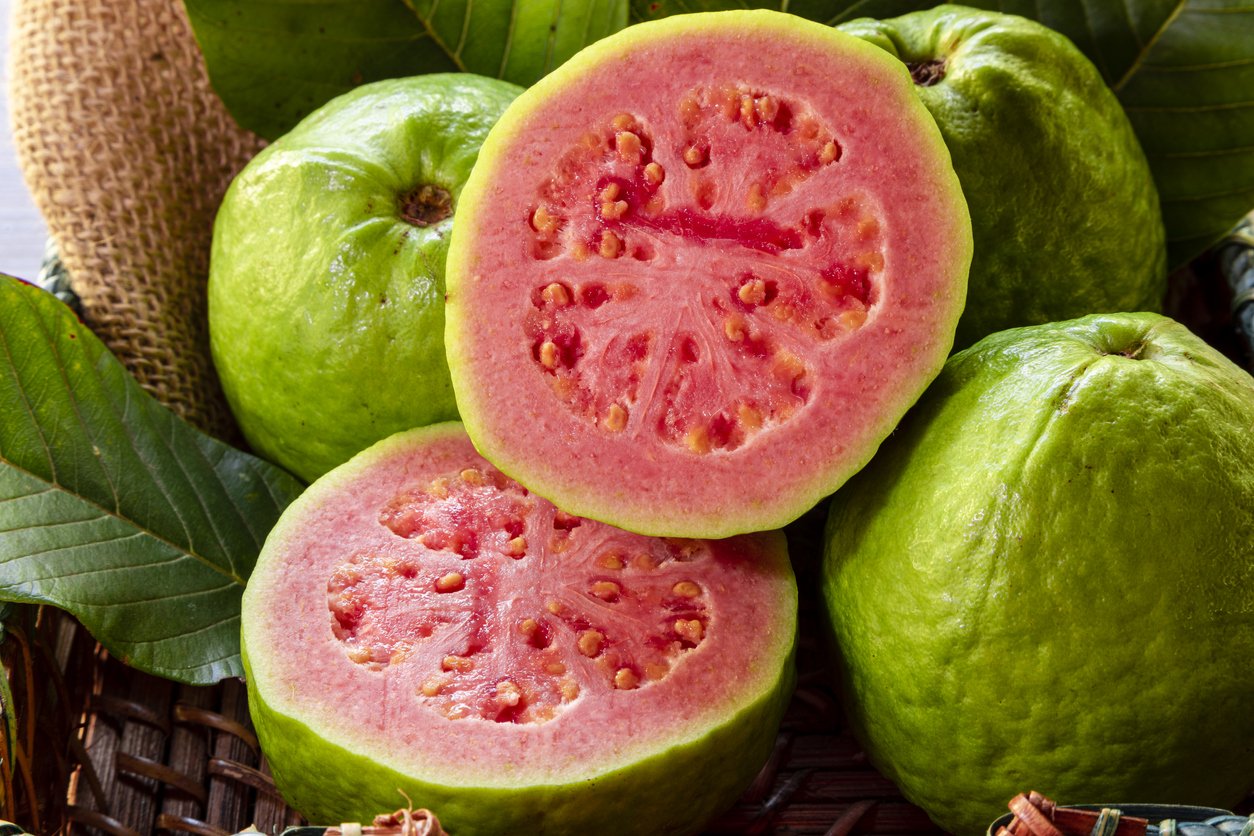
Guava, a tropical fruit, is another lycopene superstar. It actually has the highest concentration of lycopene of any food. A cup of raw guava beats out even cooked tomatoes, providing 8.5 mg of lycopene. Avoid guavas processed with added sugar, as it significantly reduces the concentration of lycopene. Cooking it is fine.
3. Watermelon

The red in watermelon is also an indicator of lots of lycopene. One cup of diced watermelon will give you almost 7 mg, which comes out to 40% more than raw tomatoes, on a pound-for-pound basis. (For our article on watermelon, click here.)
4. Papaya
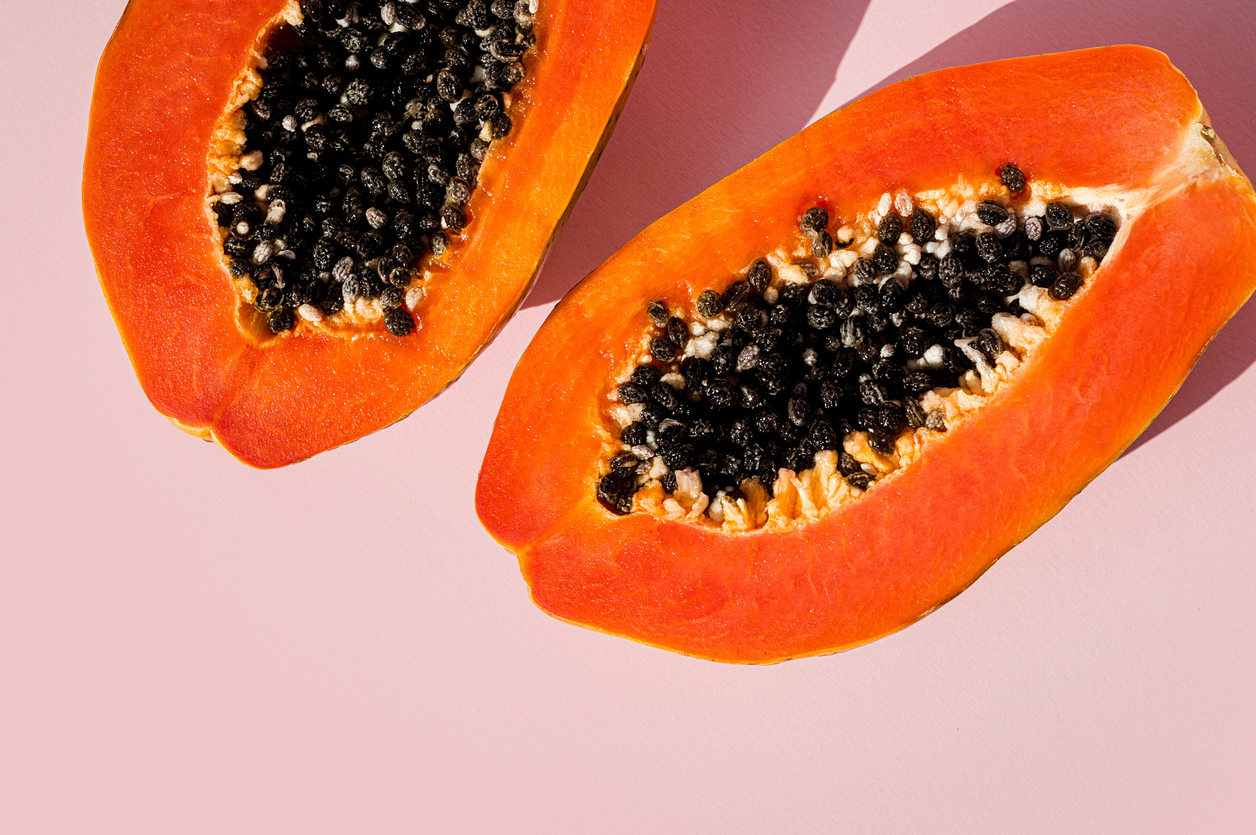
Another lycopene-containing tropical fruit is papaya. A cup of raw papaya chunks provides a respectable amount of lycopene at 2.5 mg. A lot of papayas are bioengineered (especially rainbow papayas), so pay attention to labels if you want to avoid GMO varieties.
5. Grapefruit
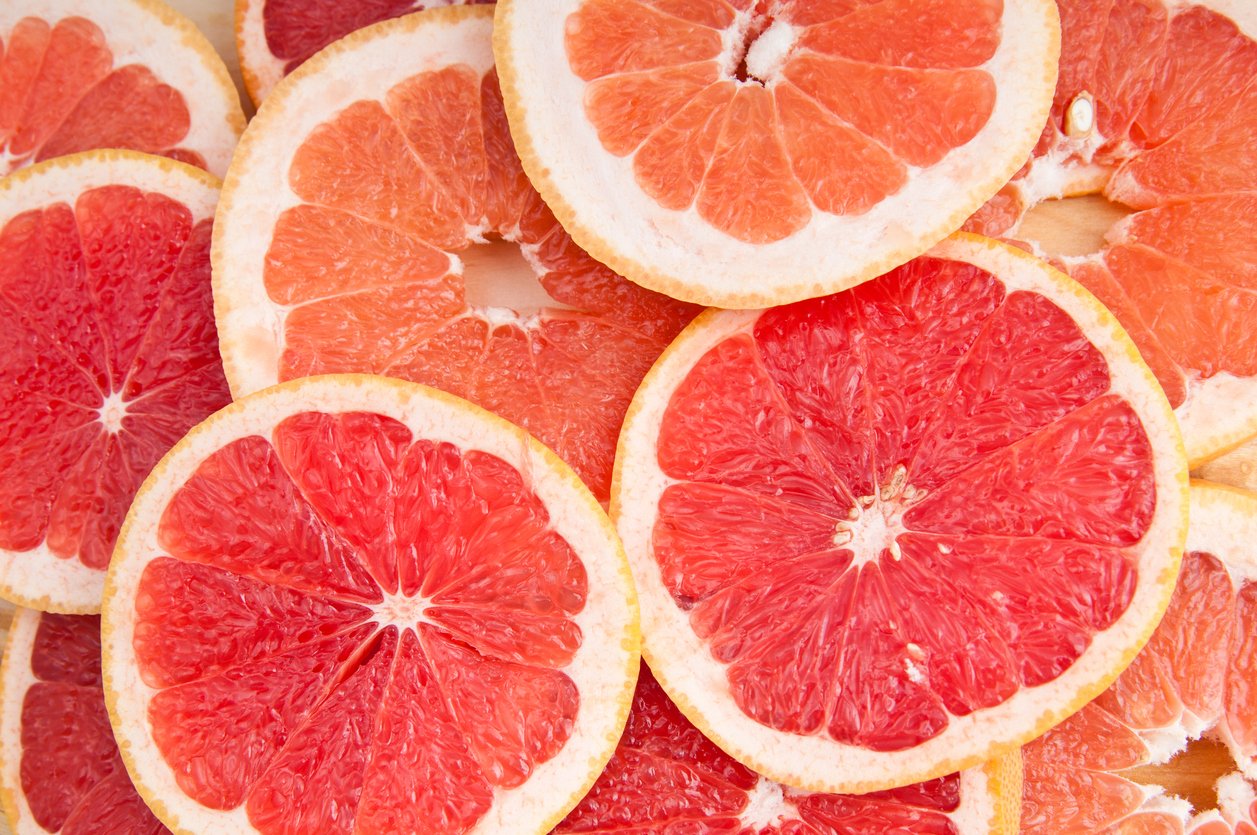
Since you know that lycopene colors food red, you won’t be surprised to learn that yellow grapefruit, for all its health benefits, isn’t a source of lycopene. Pink and red grapefruits pack a lycopene punch, however — delivering almost 4 mg per fruit.
6. Red Bell Peppers
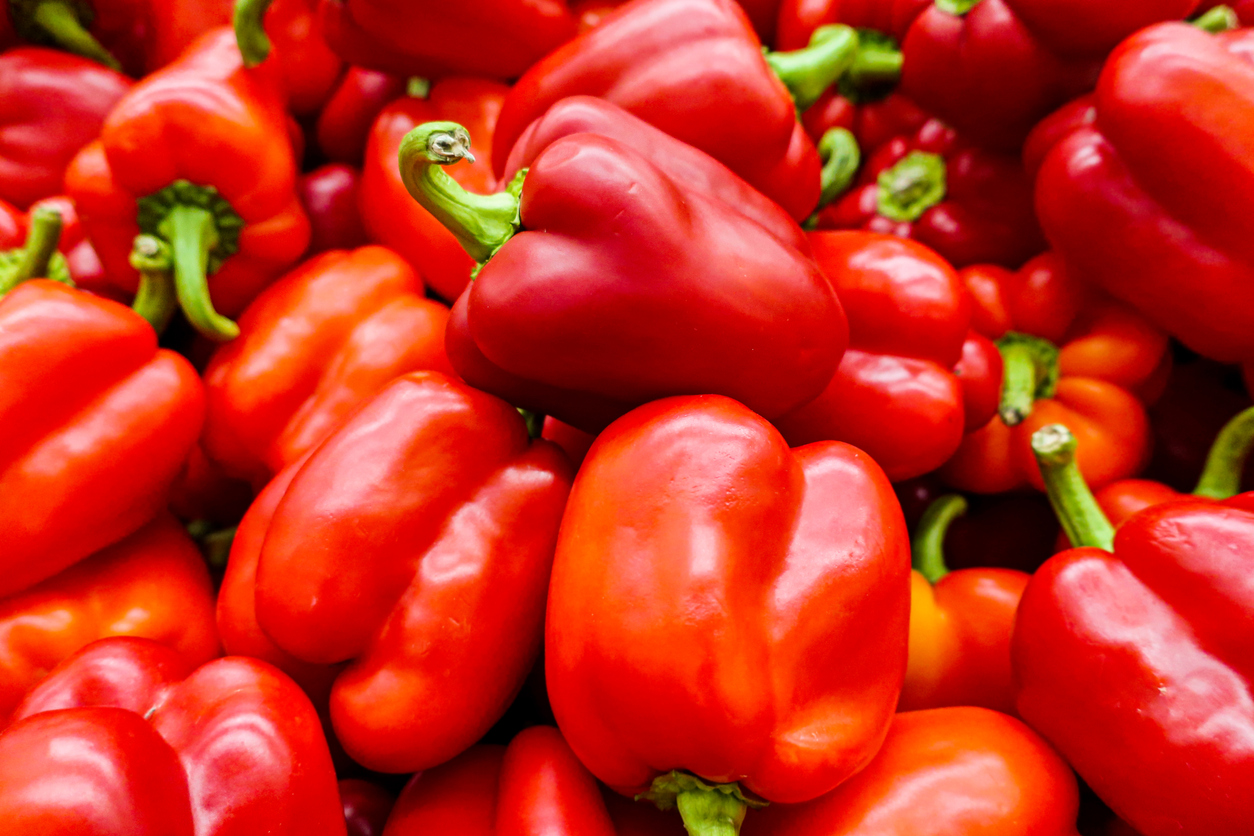
Red bell peppers have a modest amount, ranging from 0.01 to 0.5 mg per fruit. Orange bell peppers, while rich in other carotenoids, have less lycopene than the red ones. Conventionally grown bell peppers tend to be high in pesticide residue, so if you’re looking to limit your exposure, buy organic when possible, or grow your own.
7. Persimmon

The Asian persimmons that contain lycopene are actually completely different varieties from the American persimmon. A single raw Japanese persimmon, roughly 2.5” in diameter, contains a modest 0.2 mg of lycopene. And that number rises as the fruit ripens. While they are juicy and delicious, I’m not sure I could eat the 25 persimmons daily required to get me to 5 mg. Good thing I also love other lycopene foods like tomatoes and watermelons (and guavas, papayas, red peppers, and grapefruits, too)!
Lycopene Bioavailability
A lingering question in biochemistry is the extent to which lycopene, like other carotenoids, is fully bioavailable to us from the foods we consume. Unlike some foods that provide more nutrients when eaten raw, lycopene-containing fruits benefit from cooking, dehydration, and other processing methods. These techniques actually lead to the release of carotenoids and result in enhanced bioavailability.
Another way to increase the bioavailability of lycopene is to eat lycopene-containing foods with a fat source. Lycopene, unlike beta-carotene and many other carotenoids, is fat-soluble rather than water-soluble. For this reason, serving cooked tomatoes with olives or avocado (or a little olive oil or avocado oil, if you include some oil in your diet) may actually be better than eating the tomatoes raw.
Note that two people eating identical lycopene-rich foods may not absorb equal amounts. Age, gender, hormonal status, body mass and composition, blood lipid levels, smoking, and alcohol may influence the absorption of lycopene.
Some foods also have greater lycopene bioavailability than others. For example, lycopene is approximately 2.6 times more bioavailable from papayas than from tomatoes. That’s due to the way papayas store lycopene — in very small crystalloids (which are water-soluble electrolytes).
Are Lycopene Supplements Worth It?
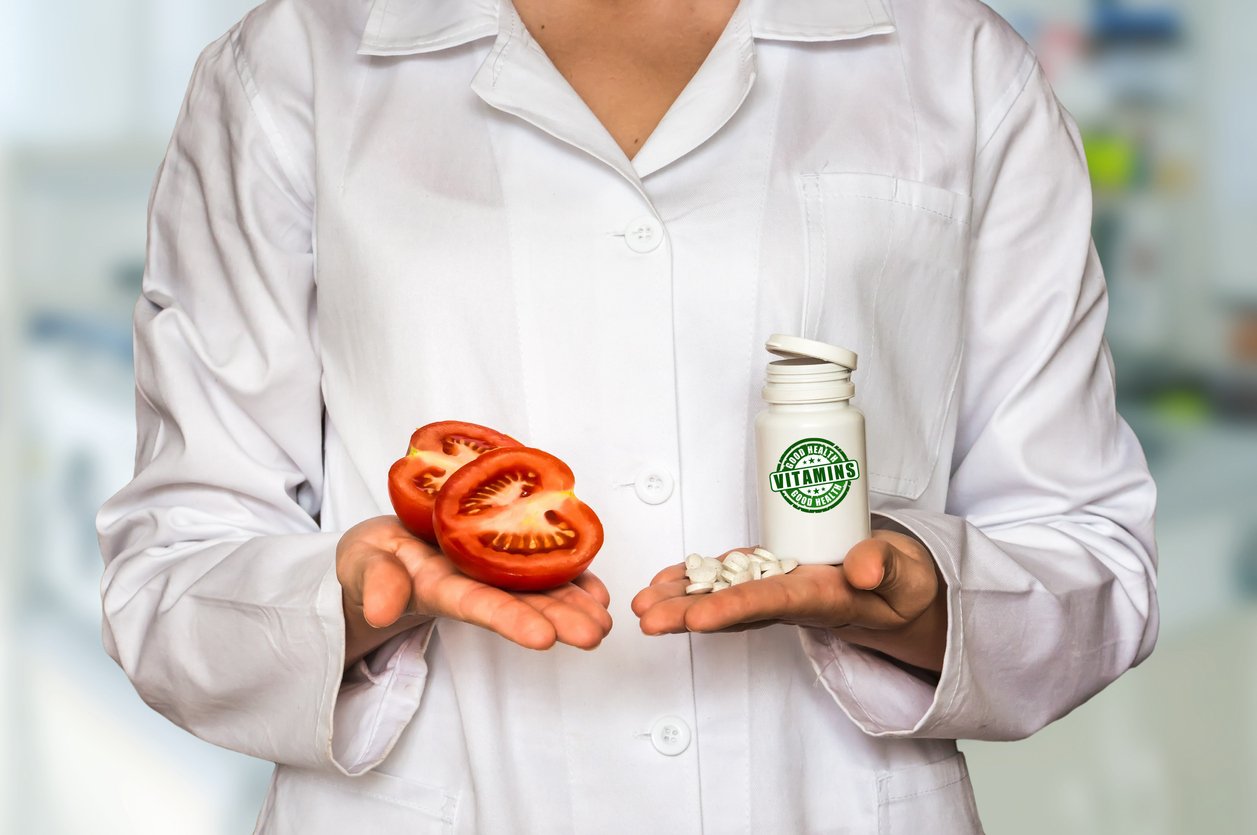
Given concerns about bioavailability, and the health benefits that lycopene can confer, it makes sense to wonder about the wisdom of supplementation. If some is good, then doesn’t it stand to reason that more is better?
Not necessarily. Lycopene supplements are highly concentrated forms of the nutrient and don’t necessarily work the same way in the body as lycopene from food. While marketing campaigns that tout “tomatoes for lycopene” and “oranges for vitamin C” aren’t incorrect, they do tend to reduce a highly complex and synergistic nutrient delivery system — a whole fruit — to a single nutrient. Tomatoes, like all plant foods, contain a variety of antioxidants that work synergistically, so they tend to be more effective than supplements, which offer isolated nutrients.
While lycopene seems to be protective against multiple chronic diseases, studies have shown that dietary sources are superior. And in some cases, supplementation might actually have a detrimental effect.
Lycopene-Containing Recipes
Below you’ll find three delicious reasons to be excited about plant-based fruits and vegetables that contain lycopene. Since lycopene is a powerful antioxidant, we are jumping for joy at the diversity of lycopene recipes you can incorporate into your diet to reap its benefits. Whether sweet or savory, these plant-based recipes are serving up some serious yum!
1. Watermelon Ceviche
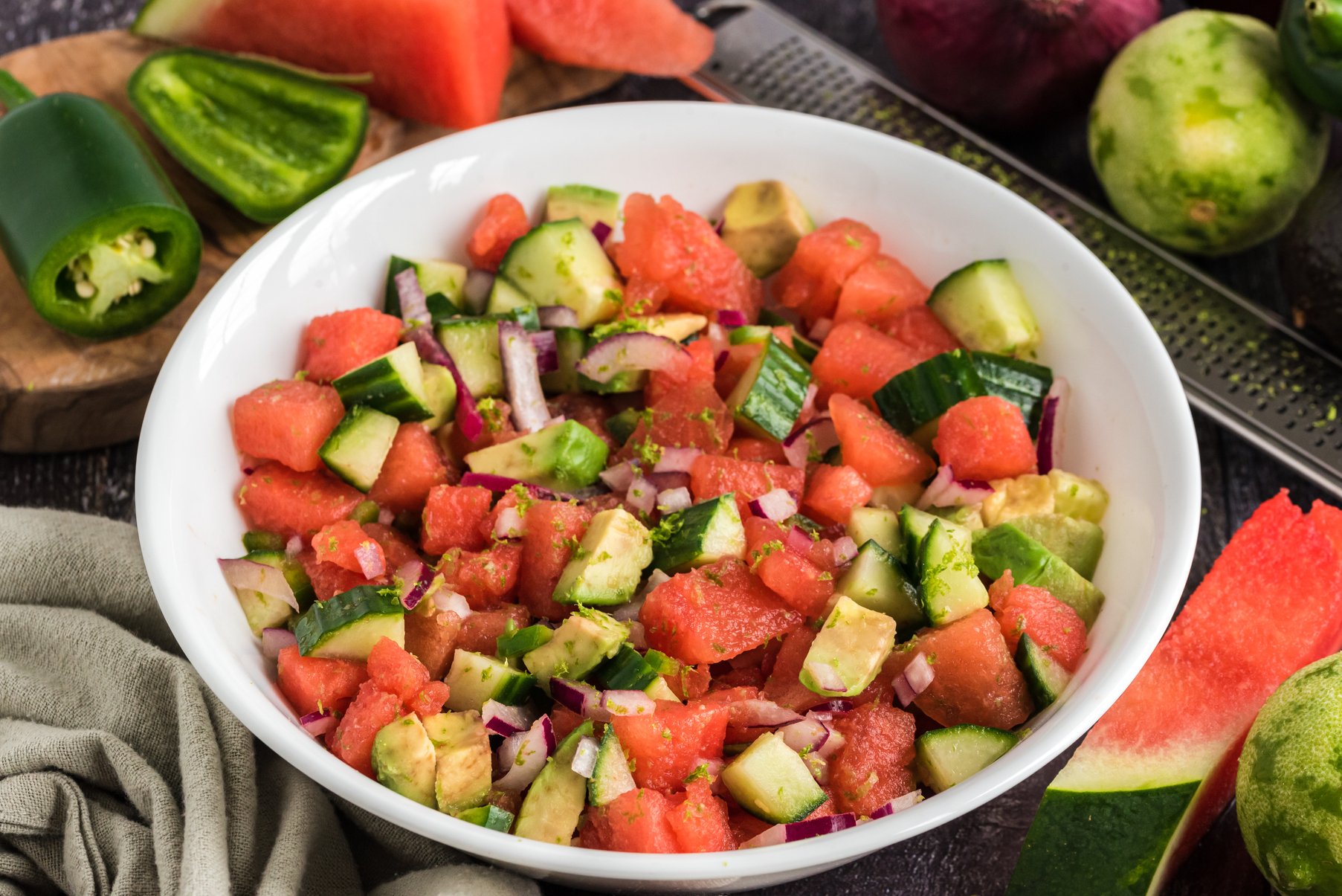
Contrary to popular belief, lycopene isn’t just found in tomatoes. It’s in several red, orange, and pink foods — like juicy sweet watermelon! This antioxidant-rich salad is sweet, refreshing, and super satisfying. What’s more, Watermelon Ceviche is packed with other healing nutrients like carotenoids and vitamin C. This easy-to-make side or appetizer is delicious alongside vegetable chips or your favorite plant-based taco recipe.
2. Basic Red Tomato Sauce
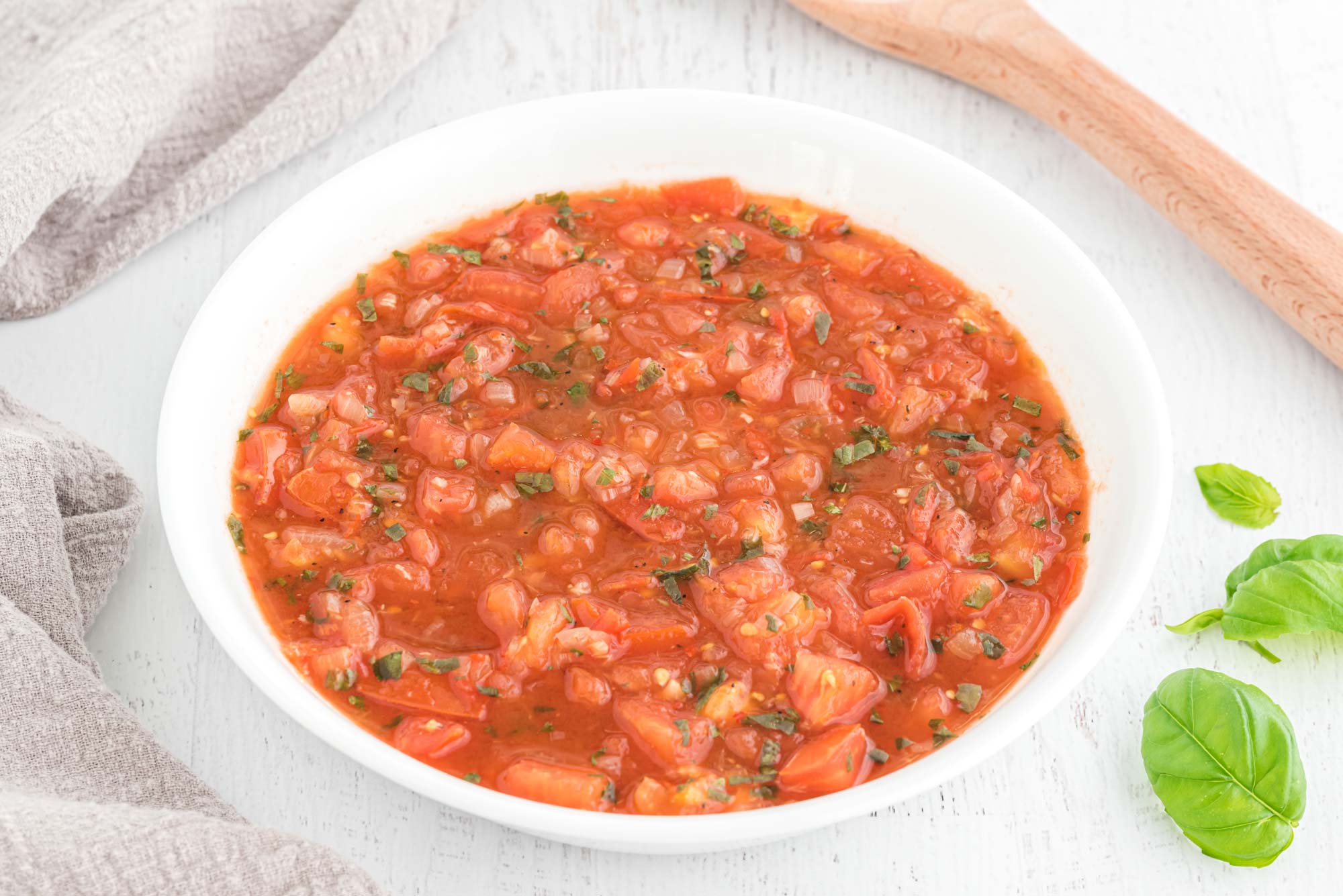
Tomatoes are lycopene-loaded, making them antioxidant-rich (and very colorful). Plus, the lycopene content in these juicy red jewels becomes even more bioavailable with heat. Cooking down tomatoes, along with fragrant spices, into a luscious and savory sauce creates a concentrated tomato delight that is delicious on hearty pasta dishes or mouthwatering pizza slices. There’s no need to spend hours standing at the stove to get that traditional Italian sauce your grandma used to make. Creating your own is simple, with just a few additional key ingredients like garlic, onion, oregano, and, of course, a little bit of love.
3. Caramelized Cinnamon Grapefruit

Pink grapefruit is one of those love ‘em or leave ‘em foods. If you typically pass it up, we’re hoping that after you try grapefruit caramelized with cinnamon and maple syrup you’ll become a lover! While those might not be two flavors you associate with grapefruit, the combination is surprisingly delightful. Also great about grapefruit (aside from its concentration of vitamin C) are its antioxidant properties. Loaded with lycopene, beta-carotene, and flavones, these antioxidants will help to keep inflammation at bay and your body feeling good!
Get Your Lycopene from Food
Lycopene is a potent dietary antioxidant that’s found only in certain plant foods. It has the potential to help protect you from many chronic diseases, and may even help reverse the progression of certain conditions. You can increase its impact and absorption by cooking lycopene foods, and by eating them with a bit of healthy fat.
While lycopene supplements exist, for most people whole foods are the best sources because of the synergistic way dietary plant compounds interact with each other and our bodies. Include lycopene-rich foods in your diet to help stave off oxidative stress and the diseases it causes – and for some culinary awesomeness.







